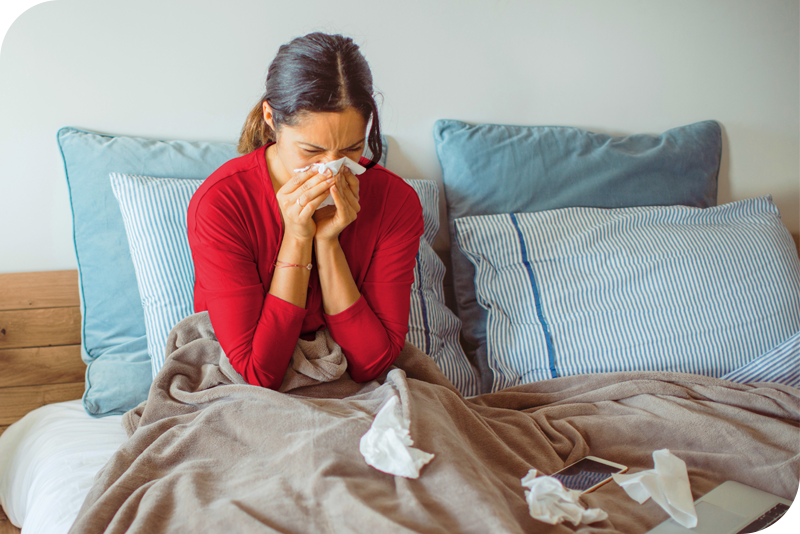Upper respiratory infections like the common cold, the flu, and COVID-19 can occur often during the colder months. These illnesses are caused by viruses or bacteria entering your body through your mouth or nose, and are usually passed from one person to another through a sneeze, cough, or touch.
When you have symptoms like a sore throat, congestion, or a cough, it can be easy to feel unsure where to get the care you need. When does it make most sense to stay at home — or to see your doctor? Read on for a detailed guide to caring for cold and flu-like symptoms.
Quick care guide
| Symptoms/ needs | Where to get care |
| Mild cough, congestion, sore throat, low fever | Home |
| Symptoms lasting longer than one week, chronic condition flare-up, medication needs | Primary care provider |
| Worsening but non-life-threatening symptoms or after-hours care | Urgent care |
| Severe breathing trouble, chest pain, confusion, blue lips, seizures | Emergency Room |
Option 1: Home care
Getting plenty of rest and fluids can help your body fight illness and recover. Over-the-counter medicine can help with pain, fever, and congestion, while humidifiers, saline spray, cough drops, and warm tea with honey (for anyone over the age of one) can help ease respiratory discomfort and throat pain.
Use for:
- Stuffy/runny nose
- Mild sore throat
- Cough
- Body aches
- Fatigue
- Low fever (rectal, forehead, or ear temperature under 100.4°F)
Option 2: Primary care provider (in-person or telehealth)
For symptoms that last more than 7-10 days, it’s a good idea to call or visit your primary care provider. You should also see your doctor if prescription or medication adjustments are needed, or if you experience:
- Repeated sinus or ear infections
- An asthma or COPD flare-up
Because your primary care provider knows you and your health history, they’ll be in a good position to provide ongoing care.
Option 3: Urgent care (walk-in or virtual visit)
When your symptoms are non-emergency but need prompt attention — mild dehydration (which might look like dizziness, not producing urine, or not being able to keep fluids down), for example, or a worsening sore throat, ear pain, or sinus pain — you should visit urgent care in person or virtually.
You should also consider urgent care when:
- You have a high fever (rectal, forehead, or ear temperature over 101°F) but are otherwise stable
- For after-hours care when your primary care provider’s office is closed
When you can, it’s always a good bet to call your primary care provider’s office first, day or night. They can often advise you on if you should visit urgent care.
Option 4: Emergency Room (ER)
When in-person care is needed right away, it’s time for emergency care. Call 911 or go to the nearest hospital emergency department immediately if you have symptoms like:
- Severe wheezing or trouble breathing
- Chest pain or pressure
- Confusion, fainting, or trouble staying awake
- Blue lips or face
- A very high fever (104°F or above) not reduced by medicine
- Severe dehydration
Care for children and babies
It’s important to keep in mind that standard care advice differs for children and babies. Learn more about getting care for kids’ cold and flu-like symptoms.
Call your doctor or seek urgent/emergency care if you notice:
- Fast or difficult breathing
- Signs of dehydration including no tears, not being able to keep fluids down, few wet diapers, or dry mouth
- A child is very sleepy or hard to wake
- Seizures
- Your baby is fussy or cries and cannot be soothed
Know where to go, get the right care faster
While most cold and flu-like symptoms can be managed safely at home or with your primary care doctor, knowing when to seek urgent or emergency care helps you get the right treatment faster and keeps emergency rooms available for life-threatening situations.
If you’re a Quartz member and need help deciding where to go for care, please visit our Getting Care page for more guidance and resources.





